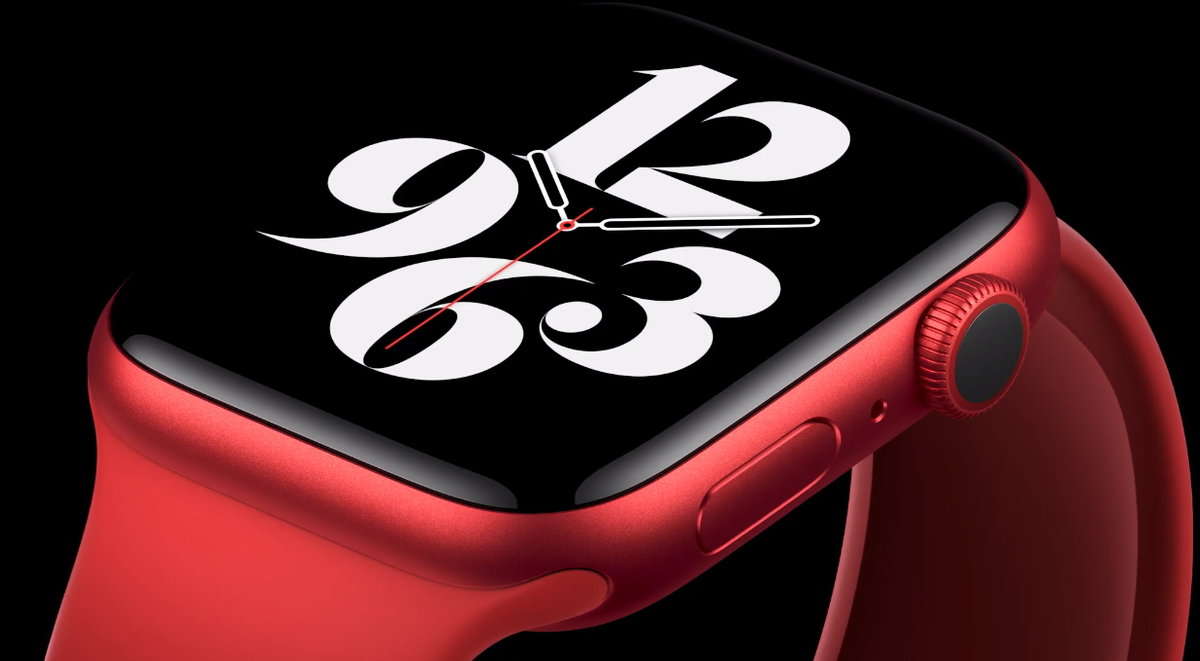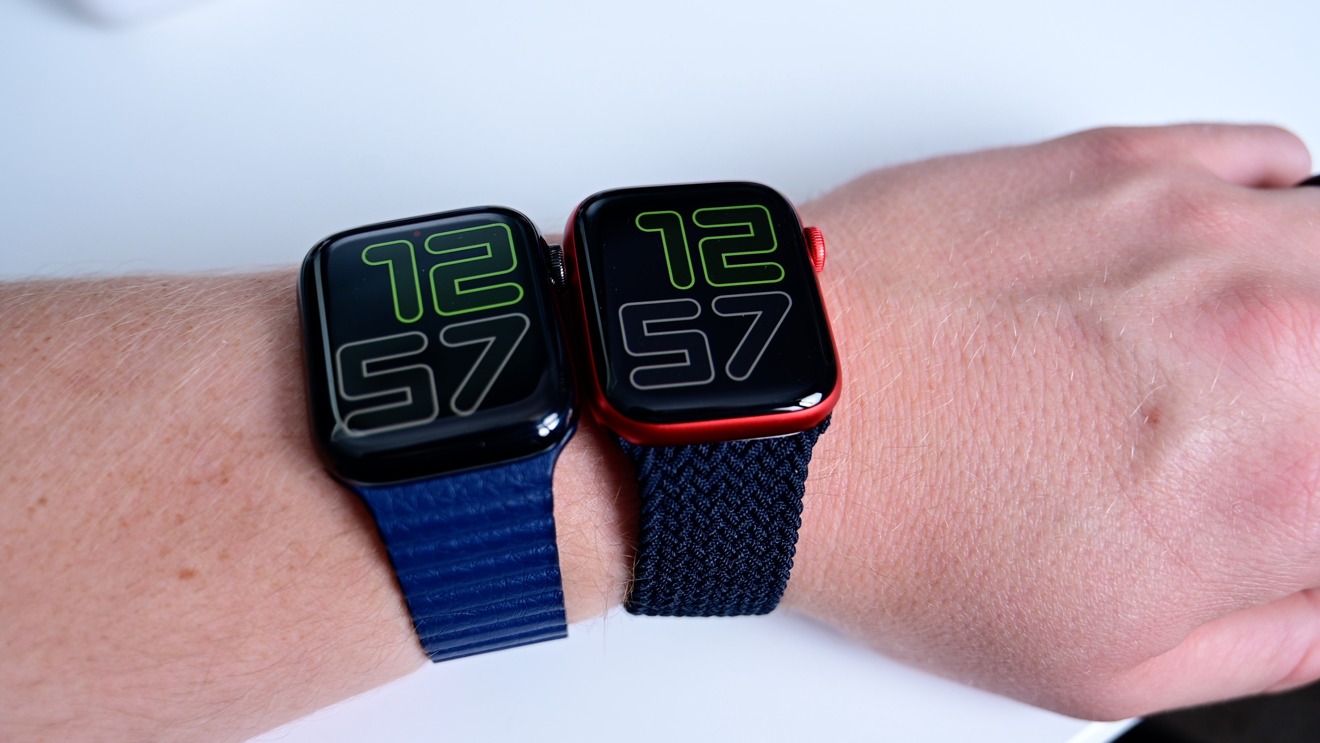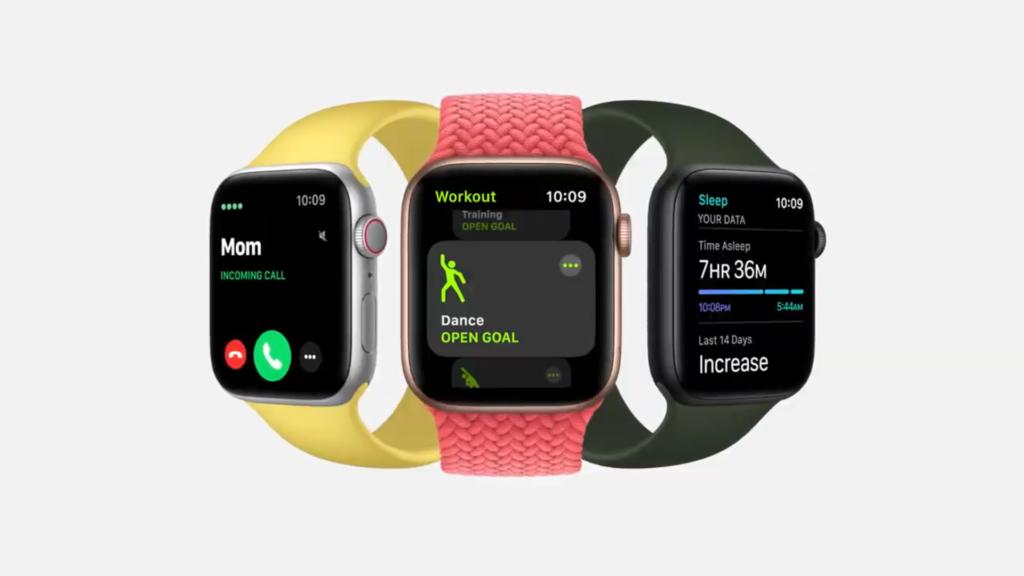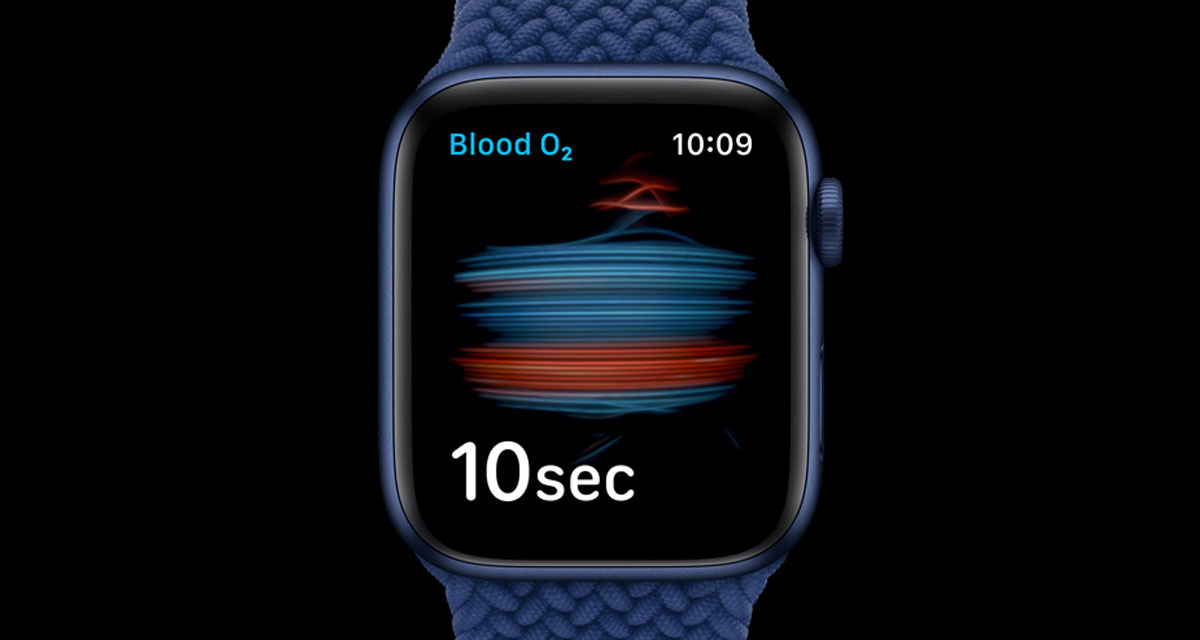The Apple Watch Series 7 offers the same suite of sensors as the Series 6. These include an accelerometer, a gyroscope, a heart rate sensor, a barometer, an always-on altimeter, a compass, an SpO2 sensor, and a VO2 max sensor. These sensors have a host of health and fitness tracking features, including blood oxygen monitoring, heart rate monitoring, sleep tracking, fall detection, workout tracking, and more. Apple Watch Series 6 improves performance through redesigned hardware that packs even more features and power into the same impressively small design.
Apple Watch Series 6 offers faster charging, completing a full charge in under 1.5 hours, and improved battery life for tracking certain workouts, such as indoor and outdoor runs. The ECG system has received clearance from the United States Food and Drug Administration, a first ever for a consumer device, and is supported by the American Heart Association. This device can also detect falls and will automatically contact emergency services unless the user cancels the outgoing call.
The microphone was moved to the opposite side between the side button and the digital crown to improve call quality. Other changes include the digital crown incorporating haptic feedback with the Apple Haptic Engine and includes the new Apple-designed W3 wireless chip. Additional features include a new S6 processor that is up to 20% faster than the S4 and S5, a 2.5× brighter always-on display, and an always-on altimeter. The S6 incorporates an updated, third generation optical heart rate sensor and also enhanced telecommunication technology, including support for ultra-wideband via Apple's U1 chip, and the ability to connect to 5 GHz Wi-Fi networks. The Series 6 watch was updated with faster charging hardware such that it completes charging in ~1.5 hours.
Force Touch hardware was removed, consistent with the removal of all Force Touch functionality from watchOS 7. The Apple Watch Series 7 continues to support Apple Pay purchases and emergency calls with SOS like previous models, and has all of the same health features, such as blood oxygen monitoring, ECG, sleep tracking, fall detection, and loud noise detection. Cupertino, California — Apple today announced Apple Watch Series 6, introducing a revolutionary Blood Oxygen feature that offers users even more insight into their overall wellness. Apple Watch Series 6 delivers many notable hardware improvements, including a faster S6 System in Package and next-generation always-on altimeter, along with its most colorful lineup yet, featuring a beautiful palette of new case finishes and bands. WatchOS 7 brings Family Setup, sleep tracking, automatic handwashing detection, new workout types, and the ability to curate and share watch faces, encouraging customers to be more active, stay connected, and better manage their health in new ways.
The Apple Watch Series 7 offers the same health monitoring features available with the Series 6. A built-in accelerometer and gyroscope enable other important health-related features such as fall detection. With watchOS 7, customers can take personalization to the next level with seven new watch face options, including Stripes, Chronograph Pro, GMT, and Artist, while curating, discovering, and sharing new watch face configurations with others. New health and fitness features, including low-range VO2 Max, sleep tracking, automatic handwashing detection, and new workout types, can help users better understand overall well-being.
Conveniently accessible on the wrist, Maps includes cycling directions and Siri offers language translation. In terms of health and wellness tracking, Apple Watch Series 6 now lets users measure their blood oxygen saturation thanks to the new health sensor that uses infrared light and photodiodes to detect colour of blood under the skin calculate blood oxygen saturation. Users will receive an alert if their blood oxygen levels drop below the reference figure between 95 and 100 percent.
The smartphone also retains the electrical heart sensor that first debuted on the Series 4 and is designed to record heartbeat and rhythm. It can detect atrial fibrillation and can provide an electrocardiogram report. Force touch technology has been removed in Watch Series 6 and Watch SE. The watch also has a side button which can be used to display recently used apps and access Apple Pay, which is used for contactless payment. If the watch's battery depletes to less than 10 percent, the user is alerted and offered to enable a "power reserve" mode, which allows the user to continue to read the time for an additional 72 hours, while other features are disabled. The watch then reverts to its original mode when recharged or after holding down the side button.
Apple's latest smartwatch is mostly an incremental upgrade from the Apple Watch 6, maintaining an 18-hour battery life, the same CPU and adding no new health features. But the enlarged display is game-changer, and makes it difficult to return to previous-generation models. The Series 7's big screen adapts wearable computing for more everyday applications, making it practical to be productive from your wrist. Apple Watch Series 6 comes with numerous features which not only mrake its appearance appealing but also very adjustable. The phone has a dimension of 44 x 38 x 10.4 mm (1.73 x 1.50 x 0.41 in) with a weight of 47.1 g (1.66 oz) Comfortable to move around.
Moreover the build of Apple Watch Series 6 is Glass front , ceramic/sapphire crystal back, stainless steel frame . It supports eSIM 50m water resistant ECG certified (region dependent SW application; HW available on all models) option through you can get accessibility to different networks. The Apple Watch Series 6 sensors include Accelerometer, gyro, heart rate , barometer, always-on altimeter, compass, SpO2, VO2max . On the other hand, if price is your main concern and you do not need advanced health functions, the Apple Watch Series 3 may be more appropriate than the $399 Apple Watch Series 7 as it offers many of the Apple Watch's core features for just $199. There are some tradeoffs with the Apple Watch Series 3 because it is a much older model, such as a smaller display, an older chipset, and the lack of a compass, fall detection, ECG, and blood oxygen monitoring.
The 1st generation Apple Watch uses the single-core S1 system-on-chip. It does not have a built-in GPS chip, instead relying on a paired iPhone for location services. It uses a linear actuator called the "Taptic Engine" to provide haptic feedback when an alert or a notification is received, and is used for other purposes by certain apps. The watch is equipped with a built-in heart rate sensor, which uses both infrared and visible-light LEDs and photodiodes. All versions of the first-generation Apple Watch have 8 GB of storage; the operating system allows the user to store up to 2 GB of music and 75 MB of photos. When the Apple Watch is paired with an iPhone, all music on that iPhone is also available to be controlled and accessed from the Apple Watch.
Apple Watch Series 4, which launched a year later, featured a major redesign with a screen that was 30% bigger in both models and a 50% improvement on its processor over the Series 3 version. Speakers and microphones were rearranged so they were louder and more useful, and Series 4 introduced the fall detection feature, ECG capabilities, and the second-generation heart rate monitor. In the past, Apple's watchOS looked similar across all its smartwatches, minus select apps exclusive to the new hardware inside a given model. Apple Watch 7 doesn't have new sensors, though, so instead the company altered watchOS 8 for a bigger screen. In addition to established features like sleep tracking, cycle tracking (which is why it's one of the best smartwatches for women,) calendar alerts, weather notifications and a Find My app for Apple Watch, watchOS 8 has a few special tricks on the Series 7.
The company also unveiled new watch faces that will arrive with watchOS 7, including GMT, Countdown, Chronograph Pro, Emoji face, Typography, Stripes, and Artist. Other watchOS 7 features include sleep tracking, automatic handwashing detection, new workout types, and the ability to share watch faces. Apple announced watchOS 7 will be released for Apple Series 3 and later models on September 16.
Users will get an optical heart rate monitor that also provides high and low heart rate notifications, apart from an irregular heart rhythm notification. Fall detection, emergency SOS, international emergency calling, and other safety features also make their way to the new Apple Watch SE, however, Blood Oxygen and the ECG apps do not. It will be available in 40mm and 44mm cases, with Gold, Silver, and Space Gray aluminium finishes. Each model through Series 3 comes in a 38- or 42-millimeter body, with the larger size having a slightly larger screen and battery.
Apple Watch Series 6 Release Date In Usa The Series 4 was updated to 40- and 44-millimeter models, respectively. Featured Apple-made bands include colored sport bands, sport loop, woven nylon band, classic buckle, modern buckle, leather loop, Milanese loop, and a link bracelet. The Series 7 is also equipped with new hardware that enables ultra-rapid, short-range wireless data transfer at 60.5 GHz, though Apple has not fully explained this new functionality. To compensate for natural variations in the skin and improve accuracy, the Blood Oxygen sensor employs four clusters of green, red, and infrared LEDs, along with the four photodiodes on the back crystal of Apple Watch, to measure light reflected back from blood. Apple Watch then uses an advanced custom algorithm built into the Blood Oxygen app, which is designed to measure blood oxygen between 70 percent and 100 percent. On-demand measurements can be taken while the user is still, and periodic background measurements occur when they are inactive, including during sleep.
All data will be visible in the Health app, and the user will be able to track trends over time to see how their blood oxygen level changes. The Apple Watch Series 6 also comes with mental health tracking features, to detect panic attacks and high levels of stress. It also offers regular breathing exercises to control your stress levels. Further, the smartwatch offers sleep tracking using a combination of accelerometer data and software tweaks available through watchOS 7. Apple claims that the Apple Watch Series 6 provides up to 18 hours of battery life. The Apple Watch Series 6 comes in 40mm and 44mm case options that both have a ceramic and sapphire crystal back finish and come in aluminium, stainless steel, titanium, and ceramic materials.
The smartwatch is powered by a new Apple S6 SiP , which is claimed to be up to two times faster than the S5 processor available on the Apple Watch Series 5. There is also a W3 wireless chip for seamless connectivity with Apple devices. Furthermore, the Series 6 is the first in its family to come with an ultra-wideband technology and the U1 chip that enable connectivity using radio waves in a short range. Apple Watch Series 6 has been unveiled by Apple at its virtual "Time Flies" event. The new smartwatch by the Cupertino giant looks quite similar to the Apple Watch Series 4 and Series 5 models. However, it does bring new hardware that is touted to deliver faster performance, better water resistance, and enhanced wireless connectivity, as per the company.
The Apple Watch Series 6 is also the first in the lineup to measure blood oxygen levels. Additionally, there are new colour options to attract a larger audience. The Apple Watch Series 7, announced in September 2021, is the current iteration of the Apple Watch that originally launched in 2015 and replaced the Series 6. The Apple Watch Series 7 builds on the design of previous Apple Watch models with a more rounded design and offers some notable new features including larger displays, improved durability, and faster charging.
WatchOS 3.0 was announced at WWDC 2016, with a priority on performance. Users are able to keep apps running in memory as well as receive background updates and refreshed information. Other updates include a new Dock invoked with the side button to replace the performance-laden Glances, an updated Control Center, and new reply options on Messages. Several new watch faces have also been added, including Minnie Mouse, along with the ability to switch watch faces from the lock screen simply by swiping.
A new app called Breathe guides users through breathing exercises throughout the day, with visuals and haptic feedback. As an ultra low-cost option, Apple is continuing to sell the Apple Watch Series 3, priced starting at $199. The Series 3 has an older design with a smaller display, a much slower S3 chip, and no blood oxygen sensor or ECG function. It is GPS only and lacks a few other bells and whistles like always-on altimeter and compass that are found in the other Apple Watch models.
The Series 3 is several years old at this point and is using outdated technology, so we do not recommend purchasing it. All Hermès models feature a silver or space black stainless steel Apple Watch body paired with one of the Hermès signature hand-crafted leather bands and an additional orange Hermès-branded Apple Watch Sport band. Hermès Apple Watches include unique watch faces based on Hermès watch designs. With the Series 7, there are color updates across the Classic, Attelage, and Jumping styles, as well as two brand new Circuit H and Gourmette Double Tour styles. The Apple Watch can now charge 33 percent faster charging compared with Apple Watch Series 6 thanks to a new charging architecture and Apple's Magnetic Fast Charger USB-C Cable and an 18W or higher power adapter. This means that just eight minutes of charging time can provide up to eight hours of sleep tracking.
The Magnetic Fast Charger USB-C Cable ships with the Apple Watch Series 7, but users will need to supply a 20W or higher power adapter to get fast charging. All Apple Watch Series 7 models feature a black ceramic and crystal back that houses four LED clusters and four photodiodes to facilitate health-monitoring features such as heart rate monitoring, blood oxygen monitoring, and ECGs. The new models feature a larger, re-engineered Retina display with more screen area due to slimmer borders. The display has a unique refractive edge that almost curves to the casing. There are interface improvements and two unique watch faces to take advantage of the larger displays.
The Series 7 continues to feature the low power OLED Always-On display technology introduced with the Series 5, allowing users to see their watch face and complications at all times. Initial reviews for the device have been generally positive with some caveats. Reviewers praised the watch's potential ability to integrate into everyday life and the overall design of the product, but noted issues of speed and price. Many reviewers described the watch as functional and convenient, while also noting failure to offer as much potential functionality as preceding smartphones. Farhad Manjoo of The New York Times mentioned the device's steep learning curve, stating it took him "three long, often confusing and frustrating days" to become accustomed to watchOS 1, but loved it thereafter. Some reviewers also compared it to competing products, such as Android Wear devices, and claimed "The Smartwatch Finally Makes Sense".
He concluded that there is no "killer application" so far besides telling the time, which is the basic function of a wristwatch anyhow. It introduced more native iOS apps such as voice memos, calculator, and a native watchOS app store. WatchOS 6.0 also introduced new features such as the noise app that allows you to measure the sound around you in decibels, menstrual tracking, and new watch faces. Other features include Siri being able to tell users what music they are listening to, activity trends, and a new UI framework for developers.
It brought back the ability for music playing on the iPhone to be controlled using the Music app on the Apple Watch and also enabled control of playback and volume on Apple's HomePod. Other new features included a new charging animation and a new app loading animation. Activity data was added to the Siri watch face, and the battery complication more accurately reports battery life. TechRadar gave it a score of 4.5/5, calling it one of the top smartwatches, while criticizing the short battery life.
Digital Trends gave it a score of 5/5, calling it Apple's best product and praising the design, build quality, and software, among others, while criticizing the battery life. CNET gave it a score of 8.2/10, calling it the "best overall smartwatch around", while criticizing the battery life and lack of watch face options. T3 gave it a score of 5/5, calling it a "truly next-gen smartwatch" due to its thinner body and bigger screen compared to the Series 3, and health features.
In comparison to other Apple products and competing smartwatches, marketing of the Apple Watch promoted the device as a fashion accessory. Apple later focused on its health and fitness-oriented features, in an effort to compete with dedicated activity trackers. The watchOS 3 added fitness tracking for wheelchair users, social sharing in the Activity app, and a Breathe app to facilitate mindfulness. Apple has also made some significant improvements to battery life and charging on the Apple Watch Series 7. The company claims that the new smartwatches offer 18-hour all-day battery life, along with 33% faster charging than the previous model. The aluminum Apple Watch models feature Ion-X glass to protect the display, while the stainless steel and titanium models use sapphire crystal glass.
Sapphire crystal glass offers better scratch resistance than Ion-X glass because it is a harder material, which means the models with sapphire crystal models are more resistant to scratching and everyday wear. When using the Apple Watch, some users have reported issues using the heart monitoring feature due to permanent skin conditions including tattoos. The Watch uses photoplethysmography technology which utilizes the green LED lights to measure heart rates. To gauge a user's heart rate, the watch flashes green light from the LEDs at the skin and records the amount of this light that is absorbed by the red pigment of the blood.
However, under certain circumstances the skin may not allow for the light absorption to be read properly and thus provide inaccurate results. WatchOS 5.0 was first shown to the public at the San Jose WWDC developer conference held by Apple. It introduced an instant watch-to-watch walkie-talkie mode, all-new Podcasts app, raise-wrist-to-speak Siri, customizable Control Center, and the ability to access the notification center and control center from apps. Other features included support for WebKit to view web pages, six new watch faces, and new workout running features. On the newest release of watchOS beta the sleep feature was shown on screen, this would eliminate the need to use third-party apps.
Using red and infrared light, the new health sensor on the Apple Watch Series 6 is able to measure the user's blood oxygen levels in just 15 seconds. This new sensor can also capture periodic background readings and store them in the Sleep app. The blood oxygen measuring feature is said to be especially useful for detecting respiratory and cardiac health issues.
This Watch brought a new S6 processor, up to 20% faster than its predecessor, a brighter Always-On display, a blood oxygen app, and an always-on altimeter, alongside new health sensors. When Apple introduced the Apple Watch Series 3 in 2017 a lot of things changed. The company started seeing the Watch more like a fitness device rather than a fashion one, although it was available in aluminum, stainless steel, and ceramic models.































No comments:
Post a Comment
Note: Only a member of this blog may post a comment.